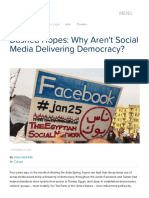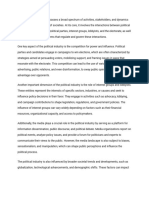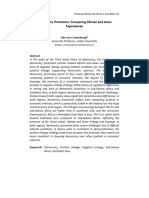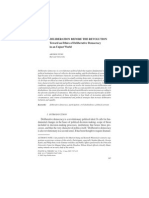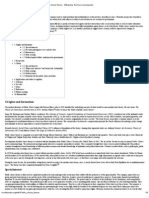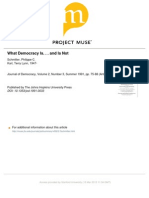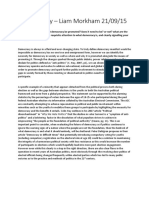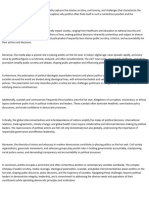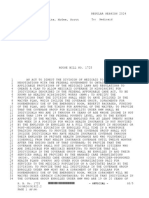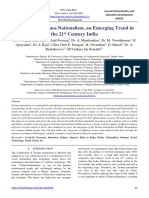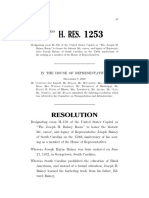Carothers Democracy Assistance Political Vs Developmental
Carothers Democracy Assistance Political Vs Developmental
Uploaded by
andreeaioana1983Copyright:
Available Formats
Carothers Democracy Assistance Political Vs Developmental
Carothers Democracy Assistance Political Vs Developmental
Uploaded by
andreeaioana1983Original Title
Copyright
Available Formats
Share this document
Did you find this document useful?
Is this content inappropriate?
Copyright:
Available Formats
Carothers Democracy Assistance Political Vs Developmental
Carothers Democracy Assistance Political Vs Developmental
Uploaded by
andreeaioana1983Copyright:
Available Formats
Democracy Assistance: Political vs. Developmental?
Thomas Carothers
Journal of Democracy, Volume 20, Number 1, January 2009, pp. 5-19 (Article)
Published by The Johns Hopkins University Press DOI: 10.1353/jod.0.0047
For additional information about this article
http://muse.jhu.edu/journals/jod/summary/v020/20.1.carothers.html
Access Provided by Lunds universitet at 09/22/10 9:13AM GMT
democracy assistance: political vs. developmental?
Thomas Carothers
Thomas Carothers is vice-president for studies at the Carnegie Endowment for International Peace. He is the author or editor of many books on democracy promotion, including most recently Confronting the Weakest Link: Aiding Political Parties in New Democracies (2006). s the field of international democracy assistance ages and to some extent matures, it is undergoing a process of diversificationin the actors involved, the range of countries where it operates, and the kinds of activities it comprises. Strategic differentiation is an important element of this diversificationdemocracy-aid providers are moving away from an early tendency to follow a one-size-fits-all strategy toward exploring varied strategies aimed at the increasingly diverse array of political contexts in the world. A defining feature of this process of differentiation is the emergence of two distinct overall approaches to assisting democracy: the political approach and the developmental approach. The political approach proceeds from a relatively narrow conception of democracyfocused, above all, on elections and political liberties and a view of democratization as a process of political struggle in which democrats work to gain the upper hand in society over nondemocrats. It directs aid at core political processes and institutionsespecially elections, political parties, and politically oriented civil society groupsoften at important conjunctural moments and with the hope of catalytic effects. The developmental approach rests on a broader notion of democracy, one that encompasses concerns about equality and justice and the concept of democratization as a slow, iterative process of change involving an interrelated set of political and socioeconomic developments. It favors democracy aid that pursues incremental, long-term change in a wide range of political and socioeconomic sectors, frequently emphasizing governance and the building of a well-functioning state. This basic division between the political and developmental approaches has existed inchoately in the field of democracy support for many years.
Journal of Democracy Volume 20, Number 1 January 2009 2009 National Endowment for Democracy and The Johns Hopkins University Press
Journal of Democracy
It has come into sharper relief during this decade, as democracy-aid providers face a world increasingly populated by countries not conforming to clear or coherent political transitional paths. Such a context impels greater attention to choices of strategy and method. Moreover, with the overall enterprise of democracy promotion now coming under stressas evidenced by the growing backlash against both democracy promotion and democracy more generallythe democracy-aid community is more actively debating the relative merits of different approaches.1 Some adherents of the developmental approach criticize the political approach as too easily turning confrontational vis-`a-vis host governments and producing unhelpful counterreactions. Some adherents of the political approach, meanwhile, fault the developmental approach for being too vague and unassertive in a world where many leaders have learned to play a reform game with the international community, absorbing significant amounts of external political aid while avoiding genuine democratization. This emergent argument easily aligns with another important division in the world of democracy aidthe difference between U.S. and European approaches. A simplistic view, tempting to some policy makers and political observers looking for easy generalizations, sees U.S. democracy assistance as basically political and European democracy-building efforts as largely developmental. Thus arguments over the possible drawbacks of both the political and developmental approaches can become arguments over whether U.S. or European programs are more effective. This is an unhelpful, incorrect line of analysis. The two core approaches political and developmentalare indeed different in important ways. Understanding their differences is useful in grasping the evolving state of democracy assistance generally. Yet both approaches have multiple pluses and minuses, which depend greatly on how they are applied in specific cases. Furthermore, although identifying the two core approaches helps to shed light on some of the similarities and differences in U.S. and European democracy aid, a simple one-on-one mapping is a mistake. Both approaches are present on both sides of the Atlantic, albeit in varying proportions. The existence of two core approaches should be seen not as a cause for conflict among democracy supporters but rather as a sign of strengthevidence that democracy aid is diversifying to adapt to a more challenging international landscape.
The Political Approach
The political and developmental approaches can be compared along several dimensions: the type of value that they place on democracy, their concepts of democracy and democratization, and their preferred methods of supporting democracy. Value of democracy: Under the political approach, democracy merits
Thomas Carothers
support above all as a positive value in itself, as the political system most likely to ensure respect for basic political and civil rights, and for political dignity generally. For practitioners of the political approach, this is reason enough to support democracy. They also usually believe that the advance of democracy in a country will contribute to social and economic development. They hold to that belief primarily out of an instinctive faith that all good things go together. This additional socioeconomic reason to support democracy, however, is secondary to the core political one. Concept of democracy: The political approach operates from what most political scientists would describe as a Dahlian conception of democracy. It highlights the importance of genuine, competitive elections and sufficient respect for political and civil rights to ensure that citizens can participate meaningfully in democratic political processes. Democracy promoters who follow the political approach sometimes add to this core of elections plus rights additional institutional features, such as an independent judiciary, strong legislature, or independent media, which they believe (usually from their own national experience) to be crucial to democracy. Wary of diluting their purely political conception, adherents of the political approach rarely extend such institutional additions to include social or economic elements. Concept of democratization: The political approach sees democratization as a process of political struggle in which political actors who can be clearly identified as democrats contend with nondemocratic forces. Democratization advances when the democrats gain the upper hand and recedes when they lose out. Although democratization may extend over a long period of time, it is a process of struggle often marked by key juncturesbreakthroughs, reversals, crises, and resolutions. Method of supporting democracy: In this conception of democratization, the central task of democracy aid is to help the democrats in a country (that is, the actors perceived as such by external democracy supporters) in their struggle against the nondemocrats. This can be done directly through assistance (whether training, advice, moral support, or funding) to the political actors themselvespolitical parties or associations, politicians, or politically oriented nongovernmental organizations (NGOs). It can also be done indirectly through support to key institutionsan independent electoral commission, an independent judiciary, or independent media, for examplethat help to level the political playing field by securing and guaranteeing fair procedures for the democratic actors and by checking the power of the nondemocratic actors. In some cases, challenging the host government may be a major focus of the political approach. In an authoritarian setting, outside actors may support political dissidents, exiled opposition groups, or offshore political broadcasting that reaches into the country. In semi-authoritarian contexts, the political approach sometimes takes the form of political-campaign training for a coalition of opposition parties competing against an entrenched
Journal of Democracy
strongman in an upcoming election. Such pro-oppositional support is usually combined with assistance to politically active civic groups working to mobilize citizens to participate in the election, as well as to independent media trying to broaden access to political information. In many other cases, however, the political approach is not prooppositional or otherwise directly challenging to an incumbent regime. Instead, it focuses on helping to strengthen all sides of a nascent or troubled democratic political process. In societies coming out of civil war, for example, democracy-aid actors may facilitate the reconstruction of democratic politicshelping all of the main political parties get back on their feet, aiding the establishment of an electoral commission, sponsoring large-scale civic-education programs, and other related tasks.
The Developmental Approach
Value of democracy: Adherents of the developmental approach believe in supporting democracy based on the conviction that basic features of democratic governancesuch as transparency, accountability, and responsivenesscontribute to more equitable socioeconomic development overall. The developmental approach thus values democracy as a contributing factor in the larger process of national development. Its proponents acknowledge that democracy is valuable in its own right for the political principles that it enshrines, but they tend to see this as secondary to a core developmental rationale. When a developing country is able to make substantial socioeconomic progress without democracy, supporters of the developmental approach are usually quite forgiving of its shortcomings on the democracy front. Concept of democracy: The developmental approach looks beyond an exclusively political definition of democracy to broader conceptions that incorporate socioeconomic concerns. In other words, it looks past political procedures to substantive outcomes such as equality, welfare, and justice. In contrast to the view of most adherents of the political approach, supporters of the developmental approach tend to see economic and social rights as being no less important than political and civil rights. Concept of democratization: The developmental approach conceives of democratization as a slow, iterative process, measured in decades and marked by the gradual accumulation of small gains. Democratization is wound in a double helix of causality with socioeconomic development: Just as the achievement of basic features of democratic governance contributes to further socioeconomic development, so too do socioeconomic gains contribute to democratization. Some adherents of the developmental approach rely on a belief in sequencing to sort out this complex causal picture. They worry about whether some countries are ready for democracy, and they hold that it is better to achieve a certain basic level of social
Thomas Carothers
and economic development, including an effective state and the rule of law, before proceeding with democratization. Method of supporting democracy: Given these ideas about democracy and democratization, aid providers who subscribe to the developmental approach incline toward indirect methods of assisting democracy, in two senses of the term. First, out of the belief in a causal relationship between the two domains, they see value in promoting social and economic development as a way of supporting democracy. Second, when they give attention to political institutions, they emphasize building state capacity and good governance (usually in a technocratic, apolitical fashion) rather than strengthening political contestation and openness. The developmental approach to democracy support almost always stresses the importance of partnership with the host government and steers clear of activities that might be seen as politically confrontational or even too political. When adherents of this approach support civil society development, for example, they typically concentrate on local-level projects aimed at addressing social and economic problems, not on national-level political advocacy or watchdog work characteristic of civil society support under the political approach. Aid providers who follow the developmental approach frequently tie their work on democracy to human rights and sometimes even cast their efforts to promote democracy as a subset of human rights work. An emphasis on human rights, thought to be more clearly rooted in universal legal principles than is democracy, appeals to supporters of the development approach as being more easily defensible against charges of external interventionism. They also see human rights as a useful gateway for integrating the political with the socioeconomic through the parallel categories of political and civil rights on the one hand and social and economic rights on the other.
Comparing the Approaches
The political approach has two principal strengths. It leads democracy promoters to give direct attention to the domain of political competition the institutional framework for competition, the degree of actual political freedom in practice, the capacities and actions of the key political actors involved, and so forth. This domain is key to democratic progress in many settings. It is a domain from which powerholders may seek to deflect outside attention by offering up reforms in other arenas, such as the social and economic. In addition, by encouraging democracy promoters to look for and respond to key political junctures, the political approach sometimes helps democracy-aid providers to find a catalytic role, such as helping to support the organizational base for large-scale civic resistance to the manipulation of an election. The main weaknesses of the political approach are the converse of
10
Journal of Democracy
its strengths. In some contexts, a focus on political competition is insufficient and limiting. Some new or struggling democracies have managed to achieve relatively open and fair political competition yet remain stuck in patterns of weak representation and a persistent disconnection of citizens from the political system. A Even very serious attempts narrow focus on the basic institutions to apply a developmental of political competition, especially approach confront a lack elections, may not help aid providers of knowledge about when to arrive at ways of broadening incluand how indirect efforts sion, representation, and participation. Similarly, attention to key junctures focused on socioeconomic is sometimes useful but sometimes reforms will cross over to not. When followed reflexively, the generate political change. political approach can encourage short-term, episodic interventions that neglect the need in many settings to support long-term, sustainable processes of political change. More generally, as some critics of the political approach point out, if it is pursued in a confrontational, highly partisan manner it can provoke serious pushback and the loss of access. Not all democracy promoters view this as necessarily bad: Some of the more vigorous practitioners of the political approach believe that a certain amount of pushback from authoritarian or semi-authoritarian governments is inevitable and a sign that democracy aid is finding its mark. The developmental approach has several potential strengths. First, an emphasis on gradual small-scale change and less politicized sectors may allow democracy-aid providers entry into tense, restrictive political situations where a more political approach might provoke a slammed door. Second, at least in contexts where some positive reform dynamic is present, the longer-term orientation intrinsic to the developmental approach encourages the sort of sustained engagement that is necessary for change in many sectors, such as rule-of-law development, where short-term efforts rarely yield results. Third, by taking a broader view of democracy, the developmental approach at least opens the door to identifying and nurturing useful links between socioeconomic reform and political reform. It is true, as some skeptics contend, that the developmental approach sometimes produces democracy programs that are indirect to the point of being toothless. Such programs allow democracy promoters to claim that they are supporting democracy in a country when all they may be doing is helping to burnish the specious reformist credentials of entrenched strongmen. Yet such cases are at the weakest end of the spectrum of applications of the developmental approach, not the norm. A softer and more common version of this weakness is that the developmental approach
Thomas Carothers
11
sometimes permits aid providers to justify a grab bag of aid programs rationalizing that they all contribute to democratization without really assessing whether the various nonassertive activities are producing larger political change. A further problem is that even very serious attempts to apply a developmental approach confront a lack of knowledge about when and how indirect efforts focused on socioeconomic reforms will cross over to generate political change. To take just one example, some rule-of-law developmentalists believe that commercial-law reform, which introduces key rule-of-law principles in the economic domain, will bleed over into parts of the legal sector more germane to political reform. This is an attractive idea, but one based more on hope than experience.2 These various strengths and weaknesses of the two approaches play out in different ways depending on the political context. Blanket conclusions about which approach is better are unhelpful. Proponents of the political approach may argue that, in authoritarian contexts, a challenging tack is the only way to unsettle a stubborn dictatorship. Proponents of the developmental approach, on the other hand, will counter that an indirect, gradual line is more likely to get inside the society and have significant effects over time. It is not clear that either is right more than a fraction of the time. Politically based approaches have for decades largely bounced off various authoritarian societies, including Burma and Cuba. The political approach struggles for traction when it is prevented by tough authoritarian governments from in-country activities and is confined to outside work, such as supporting exiled dissidents and offshore media. It may gain a footing when there is at least some domestic opposition force that is both significant and capable of making use of outside support. U.S. aid to the Solidarity trade-union movement in Poland in the 1980s, for instance, provided a useful helping hand. The risk that outside aid will delegitimize such a force is always present, however. Developmental approaches to encouraging political reform in authoritarian societies have shown little effect in such countries as Vietnam and Tunisia, where socioeconomic assistance as well as aid for legal reform, strengthening of local government, and other indirect measures have not contributed to any noticeable process of broader political reform, despite a genuine dynamic of socioeconomic progress. Some proponents of the developmental approach see signs of iterative political reform in other authoritarian countries (China, for example). Yet even in those cases, a relationship between positive developments in strengthening the rule of law or local government and a larger process of national, prodemocratic political reform remains elusive. Similarly, in some semi-authoritarian settings, the political approach can be effective, helping opposition forces and civil society activists to challenge the grip of the entrenched powerholders. The electoral revolutions in Serbia, Ukraine, and Georgia, for example, benefited from
12
Journal of Democracy
external democracy support that was based on the political approach. Some semi-authoritarian governments, however, are able to exert sufficient control to neutralize such assistance or are simply not vulnerable to challenge. Russia under Vladimir Putin is a good example in this regard. The developmental approach to democracy assistance may gain traction in semi-authoritarian states where the government creates a positive reform dynamic in the socioeconomic domain and is open to improving governance. Some developmentally oriented democracy promoters believe that Kazakhstan today is such a case. Frequently, however, the reforms trumpeted by semi-authoritarian leaders are mainly for show and are either hollow or significantly circumscribed. In such cases, democracy programs carried out under the developmental approach end up spinning their wheels, as in Egypt over the past fifteen years. Further examples could be elaborated, but the underlying point is clear: Neither approach is necessarily better than the other; the efficacy of each depends greatly on the specific country context. Of course, the impact of aid efforts carried out under both approaches depends greatly not just on whether they assume a political or developmental orientation, but whether they conform to the basic best practices of democracy aid generally. This includes tailoring programs carefully to fit the local political landscape, allowing flexibility in program design and implementation, and seeking to empower local actors rather than attempting to put external actors in the role of primary change agents.
Comparing U.S. and European Democracy Assistance
Identifying the essential elements of the political and developmental approaches and their strengths and weaknesses illuminates an issue that has gained attention during the past several years: Are there distinctive U.S. and European approaches to democracy assistance and, if so, what are they and how do they differ from each other? In the recently troubled international context for democracy assistance, democracy promoters on both sides of the Atlantic have been asking hard questions about their own approaches and those of their colleagues across the ocean. Many European providers of democracy aid are seeking a clearer understanding of how their work differs from that of their U.S. counterparts. Some do so out of a desire to define a certain distance from U.S. efforts, others in the hope of finding ground for better cooperation. At the same time, democracy promoters in the United States, recognizing that increased U.S.-European alignment could help to restore the credibility of the U.S. democracy-promotion enterprise, are beginning to give greater attention to European democracy aid. Efforts to analyze and compare U.S. and European approaches to democracy assistance often face a quandary. Both U.S. and European democracy-assistance efforts involve a wide array of different organi-
Thomas Carothers
13
zationsgovernment agencies, government-funded nonprofit organizations, for-profit development-consulting firms, and private foundations. These different actors have varied organizational interests, philosophies, methods, and styles. On the U.S. side, the institutional heterogeneity is the result of many different parts of the U.S. foreign-policy apparatus entering the democracy-assistance domain. The diversity is even greater on the European side, where a similar cacophony of types of actors is multiplied by the many countries involved as well as multilateral panEuropean actors such as the European Union. These heterogeneities mean that there is no simple, unified U.S. approach or European approach to democracy assistance. As Andr Gerrits argues:
Given these national characteristics, democracy promotion is inherently pluralistic. There is no single American or European line in democracy promotion. The democratization effort is as diverse as the democratization industry is: supranational and intergovernmental institutions, states, NGOs, political parties and affiliated organizations, etc.3
Yet despite this diversity, democracy promoters on both continents frequently talk as though distinctive, unified U.S. and European approaches do in fact exist. The way in which they describe their own and each others efforts sounds very much like the political versus the developmental approaches, with U.S. democracy assistance following the political line and European aid adhering to the developmental one. And some analytic treatments of the subject tend toward essentialist views that compare and contrast U.S. and European approaches as though each is a relatively unified whole.4 The way around this quandary is to recognize that in both U.S. and European democracy aid the two core approaches are at work, often in simultaneous and overlapping fashion. Yet while U.S. and European democracy aid draw on both approaches, the relative emphasis varies. On the U.S. side, the amount of programming rooted in the developmental approach equals or even outweighs programming based on the political approach, yet the latter defines the work of the most prominent actors and thus usually dominates the global profile of U.S. democracy aid. With European democracy assistance the developmental approach is clearly dominant, but the political approach is nevertheless also present. The Bush administrations emphasis on the Iraq intervention as the leading edge of its efforts to promote democracy caused many people around the world to conclude that forcible regime change had become the main U.S. method of democracy promotion. The Bush administration did devote an extraordinary amount of resourcesmilitary, financial, bureaucratic, and diplomaticto Iraq. Yet the overall set of U.S. policies and programs directed at supporting democracy in the world under the Bush administration was in fact a complex amalgam of efforts spanning countries in many regions and encompassing a wide range of assistance
14
Journal of Democracy
programs, diplomatic engagements, and economic carrots and sticks. Within the specific domain of democracy aid, both developmental and political approaches continued to operate, as they have since the mid1980s, when the United States began seriously engaging in democracy aid. Arriving at a straightforward conclusion about which approach is dominant is difficult.
The United States: Mixed Approach, Political Profile
The U.S. Agency for International Development (USAID), which is by far the largest funding source for U.S. democracy assistance, often follows the developmental approach. USAID is primarily a development organization, and the story of USAIDs taking up democracy support over the last twenty years is one of the often hesitant, awkward inclusion of democracy work into an organizational culture dominated by the goal of promoting socioeconomic development. Many USAID democracy programs are cautious, technocratic efforts to support incremental political change, often in the governance domain, with a studious avoidance of the political, even when political institutions and processes are being reached. At the same time, however, USAID does sometimes take a more political approachsupporting relatively assertive elections-related work, assisting political parties campaigning for an upcoming election, bolstering civil society through support for politically oriented advocacy groups, and providing aid to outspoken independent media outlets. Whether USAID tilts in a particular country toward a developmental or a political approach depends considerably on the overall U.S. relationship with the government of that country. Roughly speaking, the more positive the overall relationship, the more developmental the approach usually is; the more negative the relationship, the more political the approach. USAIDs very large but highly indirect, nonconfrontational approach to democracy aid in Egypt in the 1990s is an example of the former, and its political aid in Serbia and Belarus in the 1990s are examples of the latter. The basic orientation of USAIDs democracy assistance also depends on the outlook of the USAID mission director in a particular country. Many mission directors are traditional developmentalists who are wary of political aid and strongly inclined to the developmental approach. Only a minority bring a more political orientation to their work. With the greater centralization of control over USAIDs work as a result of Secretary of State Condoleezza Rices reorganization of U.S. foreign assistance over the past two years, this variability may diminish somewhat.5 Moreover, with the Department of State playing a greater role in overseeing USAIDs work, the agencys efforts may shift more toward the political approach. The two other principal funders of U.S. democracy aidthe National Endowment for Democracy (NED) and the Department of Stategen-
Thomas Carothers
15
erally follow the political approach, as do the most prominent nonprofit democracy-promotion organizations that they (and USAID) support, including the two political-party institutes (the National Democratic Institute [NDI] and the International Republican Institute [IRI]), IFES, and Freedom House. As a private organization, NED operates at a partial remove from U.S. foreign policy, and its political approach is thus largely its own. NEDs core credo is to find and support democrats around the world engaged in the struggle for democracythe essence of the political approach. Although NDI and IRI do some work on governance issues and give some attention to long-term, incremental institutional change, the thrust of most of their work is on the political processabove all, elections, parties, parliaments, and democratic civic activists, such as election-monitoring groups. The greater part of U.S. democracy aid, taken together from all sources and simply measured in dollar terms, probably goes to programs that proceed more from the developmental approach than the political one. This reflects USAIDs major role in the field. Yet the perceived profile of U.S. democracy aid, both domestically and internationally, is much more political than developmental. This disjunction reflects several factors. The politically oriented U.S. democracy-promotion organizations, particularly NDI and IRI, are much more visible than the many for-profit consulting firms that carry out most of USAIDs developmentally oriented democracy assistance. Moreover, the activities that these politically oriented organizations carry out tend to be much more visiblesupport for a high-profile group of student activists challenging a semi-authoritarian ruler, for example, attracts far more attention than a larger, long-term program of technocratic aid to strengthen rural municipal governance. In short, both the organizations that carry out the more political side of U.S. democracy aid as well as the kinds of programs that these organizations sponsor tend to brand U.S. democracy aid on the international scene. Political branding also occurs at another level. As noted above, during this decade the world has come to equate U.S. democracy promotion with the U.S.-led intervention in Iraq, an intervention that might be considered an extreme application of the political approach. Moreover, the U.S. involvement in supporting the color revolutions in Georgia, Ukraine, and Kyrgyzstansupport that embodied the political approachalso attracted global attention, further branding U.S. democracy support as highly political. More generally, over the past twenty years, the U.S. foreign-policy establishment (beyond the specific community of democracy-aid providers) has come to view democracy promotion as a fundamentally political rather than developmental challenge. The mainstream U.S. foreign-policy community pays primary attention to those U.S. programs that follow a political approach while largely ignoring the quieter, longer-term democracy-aid efforts that follow the developmental approach.
16
Journal of Democracy
This inclination of the U.S. foreign-policy establishment toward the political approach to democracy aid and democracy promotion generally is not hard to explain. As an assertive superpower for more than sixty years, the United States has a long-established habit, rooted in the belief that political outcomes in countries all around the world will have a direct bearing on U.S. security, of viewing the developing world (in fact, the whole world) as an arena for direct U.S. political engagement. Promoting democracy, through democracy aid and other means, is an important form of such political engagement, one way of trying to shape political outcomes favorable to the United States. Since the 1950s, the United States has taken some interest in supporting development around the world, but that interest has been based less on a concern for development per se than on development as a way to bolster political goals. These goals have included anticommunism during the Cold War and other U.S. security interests since then, from peace to antiterrorism.
Europe: Dominance of the Developmental
European democracy aid also is a complex, multifaceted domain in which one can identify both the political and developmental approaches at work. In contrast to the U.S. side, however, the developmental approach is clearly dominant in Europe. This dominance manifests itself in the following features characteristic of European democracy assistance: 1) a focus on technocratic governance work, especially capacity building for state institutions; 2) an emphasis, within civil society programming, on local-level service delivery activities and other developmental projects; 3) a linkage of democracy work with human rights support, and inclusion of social and economic rights alongside political and civil rights; 4) the treatment of elections less as pivotal political junctures and more as iterative steps on a long-term path of political change; and 5) a general tendency not to be politically challenging, to avoid linking democracy-support efforts to geostrategic concerns, and to stress the concept of partnership, even with authoritarian regimes. Richard Youngs, a leading analyst of European democracy support, distinguishes between supporting democracy as product and democracy as process, and stresses that European democracy supporters largely prefer the latter. His description of the European preference for democracy as process makes clear its basic identity with the developmental approach:
It is obvious where European sympathies lie: the record in democracy promotion efforts exhibits a clear and unequivocal preference for [a] process-oriented strategy. European democracy promoters have advocated political reform as part of a general process of social and economic modernization. . . . It is the broad direction of change in developing societies that is presented as the crucial criterion of assessment. . . . Official dis-
Thomas Carothers
17
course often even eschews the language of democracy promotion. More anodyne process-oriented aims are usually pronounced: the transformation of particular sectors; political modernization; the rule of law; pluralistic civil society.6
It is telling in this regard that the oldest and perhaps most widely recognized European organizations significantly engaged in democracy aidthe German Stiftungen or political foundationsconsider themselves to be development organizations, not democracy-promotion organizations. They present their democracy-related programs, which include extensive support for political parties and proceed on the basis of ideological partnerships with like-minded parties, as one element of a broader developmental agenda. The European bilateral-aid agencies that are large sources of democracy assistancethe Swedish International Developmental Cooperation Agency, the Norwegian Agency for Development Cooperation, and the German GTZ, for examplesimilarly treat their democracy-related programming as one part of a larger development agenda. The Barcelona Process, Europes framework for supporting reform in the Arab world, exemplifies the developmental approach with regard to the political dimension. The political-reform objectives are one element of a larger developmental framework, and the approach to supporting democratic political reform is highly gradualist. What Europeans habitually cite as the most successful, and quintessentially European, example of European democracy promotionthe accession process that brought the Central European and Baltic states into the European Unionexemplified some elements of the developmental approach. It treated political goals as an integral part of a larger package that included major social and economic reforms. It sought to include all major political actors in the target countries (rather than favoring certain actors over others). The EU accession process was, of course, underpinned by relatively strict political conditionality (no democracy, no accession), whereas the Barcelona process has lacked any such framework. In this sense, the EU accession process can perhaps be seen as a blending of the developmental and political approaches. Although the developmental approach dominates in Europe, some European organizations involved in democracy assistance do at times take the political tack. A number of European actors, including the British government, the British political parties, and some small European foundations, joined the U.S. effort to support groups opposing Slobodan Miloevi in Serbia in the late 1990sa major example of the political approach assertively applied. The new Central European actors, both governmental and nongovernmental, entering the world of democracy assistance tend toward the political approach, reflecting their more recent experience with authoritarianism and transitions away from it. Their inclination toward the political approach is evidenced in both their choice
18
Journal of Democracy
of target countriesprimarily authoritarian states such as Belarus and Cubaand their activist-oriented programming, such as efforts to help prodemocratic civic actors from Central and Southeastern Europe to share their experiences with counterparts in other places.7 Europes predominant inclination toward the developmental approach is rooted in its approach to the developing world generally. Most of the European states actively engaged in democracy assistancesuch as Germany, the Netherlands, and the Nordic countriesmaintain a strong philosophy of supporting development for developments sake in poor countries. This is not to say that they do not also pursue economic and security interests in the developing world. Some European states at times engage in political interventionism in the developing world in pursuit of their own interests. Compared to the United States, however, most European countries have a more marked pattern of supporting development goals separate from a geopolitical security framework. European democracy assistance thus belongs more to a larger development framework of engagement than to a geostrategic framework of the kind that encases much of U.S. foreign assistance. Europes preference for the developmental approach to democracy assistance also stems from the continents greater pessimism, or at least sobriety, about democracy generally. The twentieth-century European experience of punishing and sometimes violent mutations and reversals of democracy contributes to an inclination toward a cautious, buildingblock approach to political change that seeks to integrate it with social justice and economic development. In particular, the spread of fascism in Europe and the horrors committed by populist demagogues injected a deep wariness into the postWorld War II European bloodstream about the risks of elections in societies where the rule of law is weak and the socioeconomic order is under strain.8
A Division, Not a Rift
The divide between the political and developmental approaches to assisting democracy is quite basic. It starts from contrasting ideas about both democracy and democratization and leads to very different configurations of assistance programs. Yet this division need not represent a rift in the world of democracy aid. There is more than enough room for both approaches. Both have a significant place in U.S. and European efforts in supporting democracy around the world. In fact, given the ever more challenging international context for democracy assistance, the need for diverse approaches is only growing. The division between the political and developmental approaches should be understood as part of a larger process of strategic diversification that has been somewhat slow to develop in the field of democracy aid. From here, further strategic refinements should follow.
Thomas Carothers
19
In this vein, it would be useful, through further examination of the record of practical experience, to learn more about how these two approaches can be honed to deal more effectively with the three major challenges currently facing international democracy aid providers: 1) newly selfconfident authoritarian regimes pushing back against Western democracy promotion; 2) increasingly sophisticated semi-authoritarian regimes adept at imitating the forms of democracy while undermining the substance of it; and 3) weak democracies that follow basic democratic practices but experience protracted problems in building state capacity and delivering socioeconomic progress. Although such an examination will not uncover any immutable truths that dictate the effectiveness of different types of assistance, important patterns and tendencies will almost certainly come to light. Given that the difficulties of democracy support are only growing as democracy is buffeted by a host of rising challenges around the world, such insights are needed more urgently than ever. NOTES
The author wishes to thank Laurence Whitehead and Jan Zielonka for their helpful comments on an earlier draft of this article. 1. On the backlash against democracy promotion see Thomas Carothers, The Backlash Against Democracy Promotion, Foreign Affairs 85 (MarchApril 2006): 5568; and National Endowment for Democracy, The Backlash Against Democracy Assistance, Report for U.S. Senate Foreign Relations Committee, 8 June 2006. 2. Matthew Stephenson, A Trojan Horse in China? in Thomas Carothers, ed., Promoting the Rule of Law Abroad: In Search of Knowledge (Washington, D.C: Carnegie Endowment, 2006), 191216. 3. Andr Gerrits, Is There a Distinct European Democratic Model to Promote? in Marieke van Doorn and Roel von Meijenfeldt, eds., Democracy: Europes Core Value? (The Hague: Eburon Delft, 2007), 63. 4. See, for example, Jeffrey Kopstein, The Transatlantic Divide over Democracy Promotion, Washington Quarterly 29 (Spring 2006): 8598. 5. Gerald F. Hyman, Assessing Secretary of State Rices Reform of U.S. Foreign Assistance, Carnegie Endowment Paper No. 90, February 2008. 6. Richard Youngs, Democracy as Product versus Democracy as Process, in Marieke van Doorn and Roel von Meijenfeldt, eds., Democracy: Europes Core Value? (The Hague: Eburon Delft, 2007), 6768. See also Richard Youngs, Trends in Democracy Assistance: What Has Europe Been Doing? Journal of Democracy 19 (April 2008): 16069. 7. Laurynas Jonaviius, The Democracy Promotion Policies of Central and Eastern European States, FRIDE Working Paper No. 55, March 2008. 8. Hauke Hartmann, Democracy Promotion: Definition, Priorities, Preconditions, in Worldwide Promotion of Democracy: Challenges, Role and Strategy of the European Union (Berlin: Konrad Adenauer Stiftung, 2007), 3435.
You might also like
- Cities and The Health of The PublicDocument377 pagesCities and The Health of The PublicVanderbilt University Press100% (13)
- PWC-Developing Business Plan Example - GenericoDocument44 pagesPWC-Developing Business Plan Example - GenericoSyed Muhammad KamranNo ratings yet
- Journal of Democracy Volume 15 Issue 4 2004 (Doi 10.1353/jod.2004.0070) Powell, G. Bingham - The Chain of ResponsivenessDocument16 pagesJournal of Democracy Volume 15 Issue 4 2004 (Doi 10.1353/jod.2004.0070) Powell, G. Bingham - The Chain of ResponsivenessWillber NascimentoNo ratings yet
- A New Literary History of America by Greil MarcusDocument11 pagesA New Literary History of America by Greil MarcusHan Whitworth0% (1)
- Can Cuba Changes. Political Vs DevelopmentalDocument16 pagesCan Cuba Changes. Political Vs Developmentalarmado421No ratings yet
- Politics, Economics, and Pluralism ParticipationDocument7 pagesPolitics, Economics, and Pluralism ParticipationNaushaba ParveenNo ratings yet
- Koopmans (2007) - Social MovementsDocument17 pagesKoopmans (2007) - Social Movementsannakatrina51No ratings yet
- Looking For Help: Will Rising Democracies Become International Democracy Supporters?Document42 pagesLooking For Help: Will Rising Democracies Become International Democracy Supporters?Carnegie Endowment for International PeaceNo ratings yet
- Dashed HopesDocument4 pagesDashed Hopesdawson.marycsuNo ratings yet
- Pressure Groups AND Public Policy: Sangeeta Bose I.R (UG-II) Class Roll: 54Document6 pagesPressure Groups AND Public Policy: Sangeeta Bose I.R (UG-II) Class Roll: 54Muskan KhatriNo ratings yet
- Nature of Communication in PoliticsDocument1 pageNature of Communication in PoliticsanmolNo ratings yet
- Texto P2. Mediatization Effects On Political News, Political Actors, Political Decisions, and Political AudiencesDocument23 pagesTexto P2. Mediatization Effects On Political News, Political Actors, Political Decisions, and Political AudiencesLucía Águila MorenoNo ratings yet
- Testing The Empowerment Thesis The Participatory Budget in Belo Horizonte and Betim, BrazilDocument10 pagesTesting The Empowerment Thesis The Participatory Budget in Belo Horizonte and Betim, BrazilarangurensNo ratings yet
- Political IndustriesDocument2 pagesPolitical IndustriesikkinenganioNo ratings yet
- Political CommunicationDocument5 pagesPolitical CommunicationSana MalikNo ratings yet
- What Is Political ParticipationDocument17 pagesWhat Is Political Participationcoretta-clarence kimburg tannousNo ratings yet
- 3 Political CultureDocument22 pages3 Political CultureElena VoinovanNo ratings yet
- Zurn 2014 The Politicization of World Politics and Its Effects Eight PropositionsDocument26 pagesZurn 2014 The Politicization of World Politics and Its Effects Eight Propositionsnilendumishra500No ratings yet
- Theories of Political ParticipationDocument12 pagesTheories of Political ParticipationPankaj Patil100% (1)
- PoliticsDocument3 pagesPoliticscharbelkaddNo ratings yet
- 2849 8672 1 PBDocument31 pages2849 8672 1 PBMENELIK SAMUEL GESSESSENo ratings yet
- Democracy in The World Is at PerilDocument6 pagesDemocracy in The World Is at Perilktehreem3456123No ratings yet
- Wiley Center For Latin American Studies at The University of MiamiDocument6 pagesWiley Center For Latin American Studies at The University of MiamiandrelvfNo ratings yet
- Governance Driven DemocratizationDocument12 pagesGovernance Driven Democratizations7kkgjqvgcNo ratings yet
- Politics & the Struggle for Democracy in Ghana: An Introduction to Political ScienceFrom EverandPolitics & the Struggle for Democracy in Ghana: An Introduction to Political ScienceNo ratings yet
- Political ParticipationDocument18 pagesPolitical ParticipationLorenzo Taguinod EsparasNo ratings yet
- POLSCI 489 Midterm AnswersDocument6 pagesPOLSCI 489 Midterm AnswersErin SickreyNo ratings yet
- Democracy and The Media-RevisitedDocument19 pagesDemocracy and The Media-RevisitedamandaNo ratings yet
- Media N Politics Notes?Document3 pagesMedia N Politics Notes?shodaimaikeru23No ratings yet
- PoliticsDocument3 pagesPoliticscharbelkaddNo ratings yet
- Ilovepdf MergedDocument50 pagesIlovepdf MergedAmrit mishraNo ratings yet
- C123 - 12 Humss eDocument29 pagesC123 - 12 Humss eShalyn IbnosaliNo ratings yet
- Mesquita and Downs 2005 Development and DemocracyDocument6 pagesMesquita and Downs 2005 Development and DemocracyLinh ĐỗNo ratings yet
- Deliberation Before The RevolutionDocument23 pagesDeliberation Before The RevolutionErica_Anita_7272No ratings yet
- Demokratiis Finaluri KonspektiDocument17 pagesDemokratiis Finaluri KonspektizahraNo ratings yet
- English EssayDocument1 pageEnglish EssayJeet SiwachNo ratings yet
- MEDIA LAW - AssignmentDocument19 pagesMEDIA LAW - Assignmentayushree mehtaNo ratings yet
- Funding of Political CampaignsDocument458 pagesFunding of Political CampaignsFrancisco AugustoNo ratings yet
- Dahlberg & Holmberg - Understanding Satisfaction With The Way Democracy Works - Democracy Versus BureaucracyDocument30 pagesDahlberg & Holmberg - Understanding Satisfaction With The Way Democracy Works - Democracy Versus BureaucracyMudre MislicomNo ratings yet
- Theories of Democratic TransitionsDocument7 pagesTheories of Democratic TransitionscetinjeNo ratings yet
- 6 - DemocracyDocument16 pages6 - DemocracyMohamed AllouiNo ratings yet
- What Democracy Is - . - and Is Not: Schmitter, Philippe C. Karl, Terry Lynn, 1947Document15 pagesWhat Democracy Is - . - and Is Not: Schmitter, Philippe C. Karl, Terry Lynn, 1947rodolphe13No ratings yet
- Global Populisms and Their ChallengesDocument24 pagesGlobal Populisms and Their ChallengesAN725No ratings yet
- Democracy and GlobalizationDocument13 pagesDemocracy and GlobalizationMeshack O SindaniNo ratings yet
- Christie IlliberalDemocracyModernisation 1998Document18 pagesChristie IlliberalDemocracyModernisation 1998alicorpanaoNo ratings yet
- Public ChoiceDocument1 pagePublic ChoiceFrancis PalabayNo ratings yet
- The Rise of Populism in Global PoliticsDocument3 pagesThe Rise of Populism in Global PoliticsCornfed78No ratings yet
- Politics Is An Essential Aspect of Human SocietyDocument1 pagePolitics Is An Essential Aspect of Human Societyrosuser0012345678911No ratings yet
- Schmitter and Karl 1991Document15 pagesSchmitter and Karl 1991Nurlan GurbanovNo ratings yet
- Curva de Phillips. Adrian RavierDocument12 pagesCurva de Phillips. Adrian RavierLuciano VillegasNo ratings yet
- The Relationship Between Participatory Democracy and Digital Transformation in TanzaniaDocument23 pagesThe Relationship Between Participatory Democracy and Digital Transformation in TanzaniaBarikiNo ratings yet
- Johnstone y Snyder - Democracy PromotionDocument27 pagesJohnstone y Snyder - Democracy PromotionGabriela Huaman LoayzaNo ratings yet
- PYQ Unit - 1 Explaining Political CommunicationDocument8 pagesPYQ Unit - 1 Explaining Political Communicationsjuhi1805No ratings yet
- Khushi AssignmentDocument14 pagesKhushi Assignmentmanshinain08No ratings yet
- What Democracy IsDocument16 pagesWhat Democracy IsOana AlexandruNo ratings yet
- Politics Essay - Liam Morkham 21/09/15Document4 pagesPolitics Essay - Liam Morkham 21/09/15api-366102586No ratings yet
- Olsen Citizens Actions Against Nonliberaldemocratic PartiesDocument22 pagesOlsen Citizens Actions Against Nonliberaldemocratic PartiesRoberto MonteiroNo ratings yet
- The Politics On Hot SpotDocument1 pageThe Politics On Hot SpotCruspero LennyNo ratings yet
- Besley Identity PoliticsDocument63 pagesBesley Identity PoliticsWalterNo ratings yet
- What Democracy Is and Is NotDocument15 pagesWhat Democracy Is and Is NotMariam SomkhishviliNo ratings yet
- Project 6 Signature AssignmentDocument9 pagesProject 6 Signature Assignmentapi-722214314100% (1)
- Senior Project Final PaperDocument11 pagesSenior Project Final Paperapi-604627665No ratings yet
- FY24 State Foreign Operations and Related Programs - Bill SummaryDocument10 pagesFY24 State Foreign Operations and Related Programs - Bill SummaryKyle Becker100% (1)
- 1 Jefferson Madison Monroe NotesDocument3 pages1 Jefferson Madison Monroe Notesapi-294843376No ratings yet
- Marxism, Reparations and The Black Freedom StruggleDocument212 pagesMarxism, Reparations and The Black Freedom StruggleMosi Ngozi (fka) james harrisNo ratings yet
- Gov. Tom Wolf's LetterDocument1 pageGov. Tom Wolf's LetterPennLiveNo ratings yet
- H.B. 1725Document24 pagesH.B. 1725Anthony WarrenNo ratings yet
- School Calendar 2018 2019 Portrait Year at A GlanceDocument1 pageSchool Calendar 2018 2019 Portrait Year at A Glanceileana stoicaNo ratings yet
- Majority and Minority Group RelationsDocument6 pagesMajority and Minority Group RelationsAndrew Rollings100% (8)
- I I T P I: F Were HE Resident of NdonesiaDocument12 pagesI I T P I: F Were HE Resident of NdonesiaPhilip SembiringNo ratings yet
- Proclamation of Amnesty and ReconstructionDocument4 pagesProclamation of Amnesty and Reconstructionapi-442429144No ratings yet
- CU Amicus Brief - Moore v. HarperDocument40 pagesCU Amicus Brief - Moore v. HarperCitizens UnitedNo ratings yet
- A Study On Techno-Nationalism, An Emerging Trend in The 21st Century IndiaDocument13 pagesA Study On Techno-Nationalism, An Emerging Trend in The 21st Century IndiaPoonam KilaniyaNo ratings yet
- As Filed PetitionDocument67 pagesAs Filed PetitionNick ReismanNo ratings yet
- PDF Up Media RR PresidentsDocument2 pagesPDF Up Media RR PresidentsAndrei RobaNo ratings yet
- NC Supreme Court Opinion in Harper V HallDocument217 pagesNC Supreme Court Opinion in Harper V HallJordan SchraderNo ratings yet
- Section III - Topic 3Document7 pagesSection III - Topic 3KARINE HOVSEPYANNo ratings yet
- Dwnload Full Understanding Financial Accounting Canadian 2nd Edition Burnley Solutions Manual PDFDocument35 pagesDwnload Full Understanding Financial Accounting Canadian 2nd Edition Burnley Solutions Manual PDFmittelstaedtmadlynus100% (20)
- 2.1. Miêu Tả Và So Sánh Số LiệuDocument13 pages2.1. Miêu Tả Và So Sánh Số Liệuthvl3105No ratings yet
- Hailey Kroischke - The GG Background HyperdocDocument6 pagesHailey Kroischke - The GG Background Hyperdocapi-525640158No ratings yet
- U.S. Sugar Land Purchase Letter - Governor Scott - September 2013 - FINAL (2) - 09 23 13Document3 pagesU.S. Sugar Land Purchase Letter - Governor Scott - September 2013 - FINAL (2) - 09 23 13Alan FaragoNo ratings yet
- Unit 3 Population and Migration QuizDocument4 pagesUnit 3 Population and Migration QuizAmare BaptisteNo ratings yet
- Global Disparities in Knowledge Production Within Journalism Studies Are Special Issues The AnswerDocument21 pagesGlobal Disparities in Knowledge Production Within Journalism Studies Are Special Issues The AnswerLuiz Otávio prendinNo ratings yet
- BILLS 116hres1253ihDocument4 pagesBILLS 116hres1253ihBernewsAdminNo ratings yet
- China Golf Industry ReportDocument11 pagesChina Golf Industry Reportgasbbound1No ratings yet
- Supreme Court - Wellons IIDocument1 pageSupreme Court - Wellons IImarkbermanNo ratings yet
- Wednesday, August 19, 2015 EditionDocument16 pagesWednesday, August 19, 2015 EditionFrontPageAfricaNo ratings yet
- USA Non-Immigrant Investor Visa Application FormDocument4 pagesUSA Non-Immigrant Investor Visa Application FormMedley, Hahn and PartnersNo ratings yet









